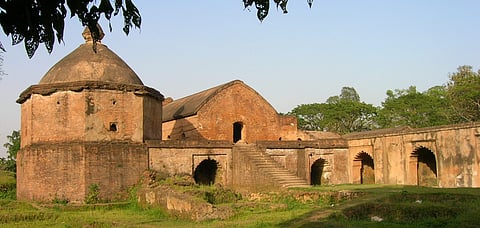

India's rich history has left behind grand reminders of it through the many monuments. While some have sustained and been recognised for their beauty, many still stand gloriously hidden in plain sight, holding tales as timelessly fascinating. If you have always been in search of these stories, make your way to the following lesser-known but unique historical monuments in India.
Talatal Ghar, Assam
Built by the Ahom ruler Swargadeo Rudra Singha in the 18th century, the seven-storeyed palace is a brilliant example of Tai Ahom architecture. Built as an army base, Talatal Ghar has three underground levels, two levels above the ground known as Kareng Ghar, and two secret tunnels, one of which connects to the Dhikhow River and another to the Garhgaon Palace, almost 10 km away. The palace was not only used to escape when conflict arose but also as a royal court and administrative office. The ground floor is lined with stable rooms, servant quarters, and store rooms functional during the Kingdom's rule. Situated just 3 km from the famous Rang Ghar, Talatal Ghar often gets overcast by the former's beauty. Still, it is worth visiting for its architectural brilliance and the historical stories that inspired it.
How to reach The nearest railway station to Talatal Ghar is Sibsagar, 4.7 km away and well connected to major cities. You can easily find a cab or auto rickshaw from the station or take a bus from the nearby Sibsagar Bus Stand. Affordable rates and luxury options are available.
Rabdentse Ruins, Sikkim
After Yuksom, Rabdetnse became the second capital of the Kingdom of Sikkim when Tensung Namgyal took over the throne in 1670. However, when Tensung Namgyal's son from his second wife succeeded in 1700, his half-sister Pendiongmu (from Tensung's first Bhutanese wife) in spite, evicted Chador Namgyal with the help of the Bhutanese. Chador took to exile in Tibet for a decade before returning to reclaim his territory with the help of the Tibetans. Decades of ravages followed as different rulers succeeded, and the quest for power led many to wreak havoc in Rabdentse. Severe tensions between the Nepalese and the Bhutanese concluded with the Gurkhas reducing the erstwhile ancient capital to ruins in the late 18th century.
The Archaeological Survey of India has declared Rabdentse a heritage monument and implemented restoration measures. Remnants of tribulations, the ruins are the best way to learn about the Kingdom's different passages of time. And if you have always had Machu Picchu on your list, Rabdentse ruins is the closest you will come to in India.
How to reach The nearest airport is located in Siliguri, about 137 km away, and the nearest railway station is in New Jalpaiguri. From either, hail a cab to Pelling and then trek to Rabdentse ruins.
Masroor Temples, Himachal Pradesh
In the picturesque Kangra valley of Beas River lies an unbelievable discovery. These 8th-century rock-cut temples facing the Dhauladhar range are dedicated to Shiva and lie unexplored despite their breathtaking beauty. While most of the structure has been damaged over the decades by natural calamities and reliefs have been lost, the temple carved out of monolithic rock continues to mesmerise whoever visits them. And even though the temple complex as it was planned was never completed, the remains hold enough fascinating tales to capture a history lover's imagination. Apart from the ambitious Nagara architectural style adopted to build the central shrine and its surrounding temples, one of the most interesting features remains the reliefs of Vedic and Puranic gods and goddesses and inscriptions from sacred Hindu texts.
How to reach Gaggal is the nearest airport, and Daulatpur Chowk is the nearest railway station. From either, you can hail a private cab to Masroor.
Kanch Mahal, Uttar Pradesh
The mention of Agra conjures up images of the pristine Taj Mahal, the sprawling Agra Fort and the spectacular Sikandra Fort. Amidst these many names, Kanch Mahal goes without any mention. But one look at its deep-red facade embellished with intricate carvings will enchant you. And the history residing within its walls adds to its inherent charm. Built around 1609 under Emperor Jehangir's patronage as a hunting lodge and for women royalty, the Kanch Mahal still revels in the beauty characteristic of the Mughal Architectural style. The most stunning aspect of this mahal is the colourful tiled ceiling featuring mosaic patterns and the wooden carvings that adorn the main doorway.
How to reach You can easily reach Agra via train or car from major cities like Delhi, Lucknow, and Jaipur.
Maluti Temples, Jharkhand
In a village named Maluti, located near Shikaripara in Jharkhand's Dumka district, a cluster of 72 terracotta temples, belonging to the 17th century, stands. As per beliefs, the 16th-century town was complete with 108 temples, depicted in the sagas of Mahabharata and Ramayana. However, the remaining 36 have been lost to the mystery.
The town is imbued with historical significance as the erstwhile capital of the tax-free nankar Kingdom under King Baj Basanta. The King and the town's other residents built the 108 temple complex in devotion to Goddess Maulikha of Maluti. Due to the town's rich history, the temple town has been listed among the "Most Endangered Cultural Heritage Sites in the World" by the Global Heritage Fund.
How to reach Take a train to Rampurhat or fly to Kolkata and hire a cab to Maluti. The distance between Rampurhat and Maluti is only 13 km.
